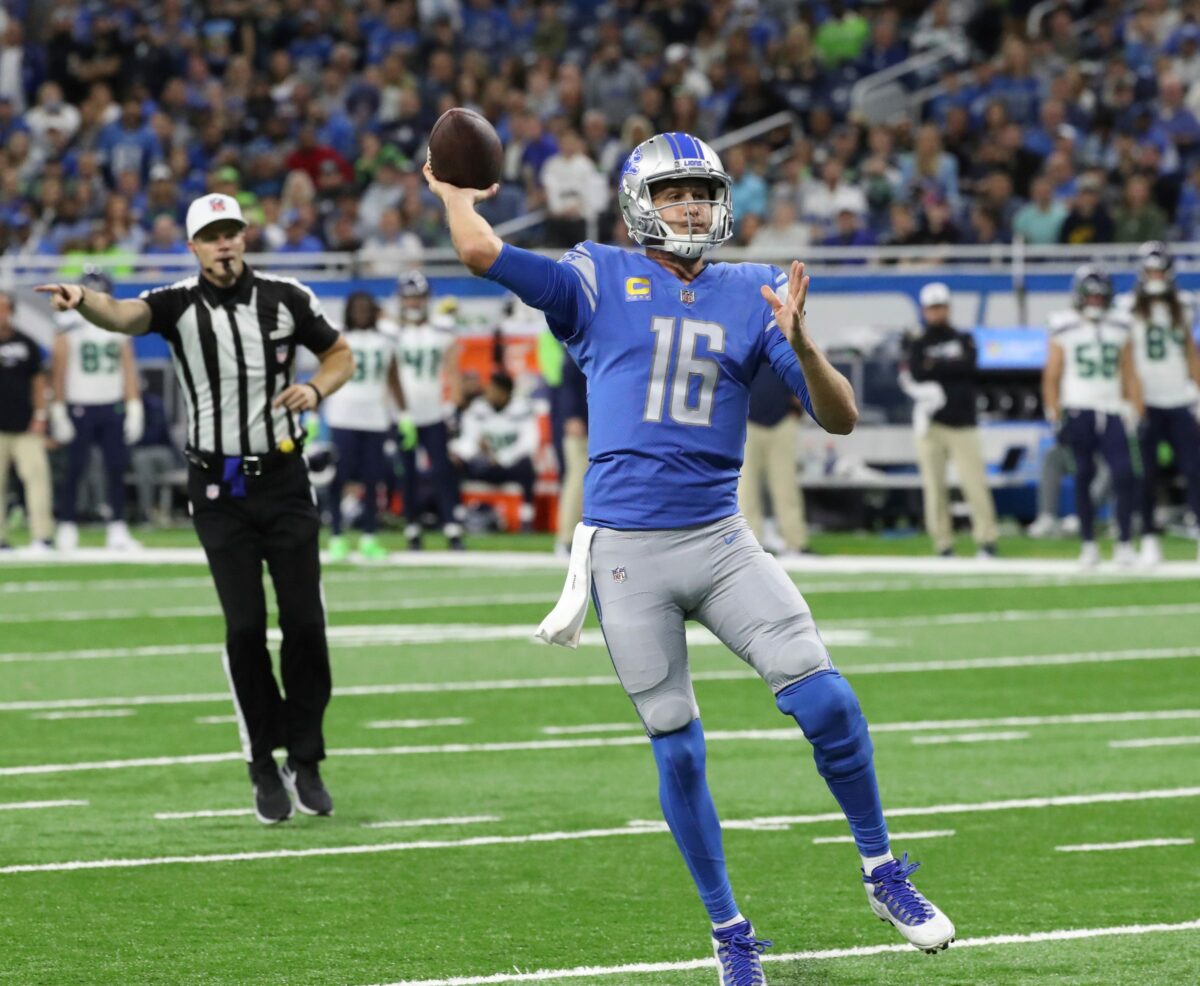Lions QB Jared Goff said he needs to “find a way to be at my best”, so here are a couple of suggestions to help Goff achieve his goal
There are a lot of fingers to point when looking for reasons the Detroit Lions offense has managed just six points in the last two games. Many of those fingers are directed at quarterback Jared Goff, who has not played well in those humiliating losses.
It was nice to hear Goff own up to his own poor play. Prior to Wednesday’s practice, Goff met with the media and offered something of a mea culpa for the offensive struggles in the losses in New England and Dallas.
“In my part, in the last two weeks I wasn’t at my best,” Goff acknowledged. “I need to find a way to be at my best and continue that through the rest of the season.”
In the spirit of helping Goff find those ways to be at his best, here are a couple of implementable suggestions for the Lions QB that goes beyond simply “play better” or “stop fumbling”, though those are pretty valid generalizations that would be nice…
Get back to throwing deep
The biggest change in Goff from his largely suboptimal 2021 debut season in Detroit and his impressive turn in the first four weeks of 2022 was his willingness to attack down the field. Air yards per attempt track how far the ball traveled beyond the line of scrimmage to its intended target.
After seven weeks, the NFL mean air yards per attempt amongst QB with at least 100 snaps is just under 7.5. Goff currently sits at 8.04, but the splits are heavily skewed between the first four games and the last two.
Detroit’s offense led the NFL in scoring and ranked among the most efficient through the first four weeks. In those games, Goff’s lowest air yards per attempt average was 8.03. The last two games, Detroit has not scored a touchdown and managed just two field goals.
In those games, Goff’s air yards per attempt are down to just 6.57. It shows in the team’s overall offensive efficiency, which has plummeted to 18th from 6th just three weeks ago.

Game log graphic and data from The 33rd Team
Obviously, not having deep threat DJ Chark at all and missing top WR Amon-Ra St. Brown for all but 10 plays in those games creates some impact here. But Goff has also reverted back to the bad habit he showed in 2021 of reading the field from short to long, not the other way around. He’s a much better quarterback when he doesn’t ignore the deep shots.
Note that this is not a playcalling issue from coordinator Ben Johnson nearly as much as it is Goff simply not trying to push himself, or push the offense down the field. Goff either didn’t see or ignored eminently makeable open target options deeper down the field than the ones he chose. I counted eight such realistic options in the film review from Dallas. That includes the first interception Goff threw, a late and underthrown ball to a well-covered Josh Reynolds down the left sideline. If Goff turns his head 15 degrees to his right, he’s got T.J. Hockenson wide open for an easy pitch-and-catch some 20 yards down the field. Choosing the right downfield option is important too.
Consistent depth on his drops
This was something that former Lions offensive lineman T.J. Lang pointed out during and after the loss in Dallas. As Lang noted, Goff has a tendency to drift off his spot in the pocket, or drop too deep relative to the design of the play.
As an example, I’ll borrow from Jeremy Reisman of Pride of Detroit because he captured a great shot here. Try if you can to just focus on Goff and where he’s at, with his back foot behind the 32-yard line.
The line of scrimmage is the 40. The play here calls for a 7-step drop. That means Goff’s back foot should hit the 33-yard line and the ball comes out, or he’s at least ready to unload. But he’s over a yard too deep. LG Jonah Jackson has successfully blocked his man beyond where he should be a threat to Goff, but the QB isn’t where he’s supposed to be. It throws off the protection, not to mention the designed angles to make the throw. That missed opportunity and sack are 100 percent Goff’s fault.
And he knows it all too well.
When asked about his tendency to drift or not have precision on his drop depth, Goff noted it’s something that was an issue for him in Los Angeles in his five seasons with the Rams.
“No, no, it’s always something – yeah, no, it’s like a – I think about when I was back in LA, and those tackles are constantly talking to you like, ‘Hey man, once you get past that spot, you’re on your own’,” Goff said.
To that end, Goff thinks a sharper focus and practicing this more will mitigate the issue.
“And I think as you get older, you’re like, ‘OK, I’ll be on my own and see how it goes.’ And no, that’s not the right mentality to have,” Goff continued, “Like, move up in the pocket and again, not to make light of it, but yeah, move up in the pocket and do my job, and again, I don’t see it as something that I’ll continue to do.”
Goff has proven he can do these things well when he focuses on them. It’s incumbent upon Goff to do just that, and for QB coach Mark Brunell, Dan Campbell and Ben Johnson to make sure it’s happening. Detroit’s offense can just as easily score six points in two games with backup Nate Sudfeld at the helm for tens of millions less than Goff is earning.
[mm-video type=playlist id=01eqbx8sj47vkwrznr player_id=none image=https://lionswire.usatoday.com/wp-content/plugins/mm-video/images/playlist-icon.png]



